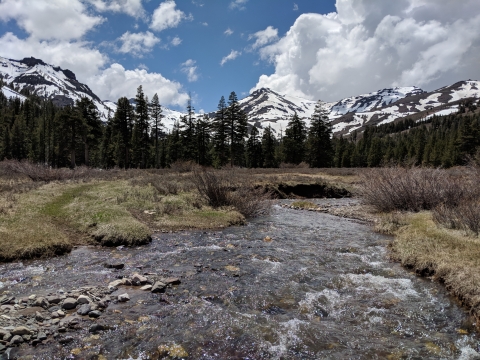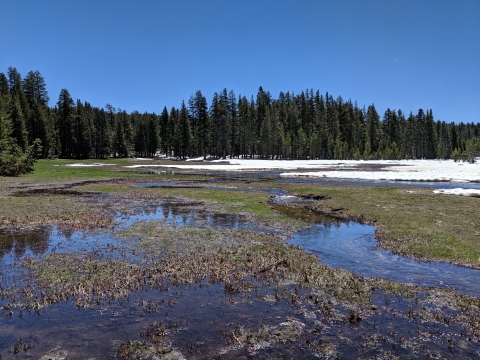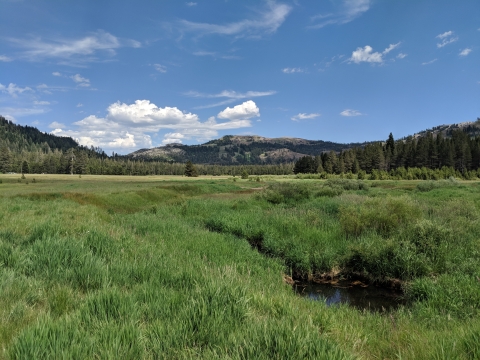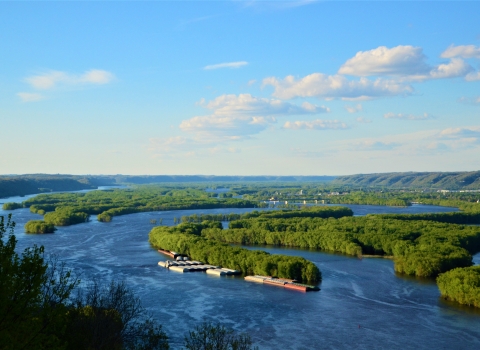Meadows are often the subject of beautiful photographs and paintings, with colorful grasses swaying in the wind and creeks winding through the scene. But beyond their beauty, meadows provide important services to people and wildlife.
“Meadows are a great form of green infrastructure,” said Ian Vogel, a wildlife biologist in the U.S. Fish and Wildlife Service’s Sacramento Field Office. “They clean our air, contribute to a reliable water supply and provide essential habitat for wildlife.”
Vogel is part of a network of federal and state agencies and environmental groups known as the Sierra Meadows Partnership. The Partnership creates and implements strategies to restore meadows throughout the Sierra.
“Over the past 150 years, meadows in the Sierra have deteriorated from a variety of natural and manmade causes,” said Vogel.
Some of those issues include overgrazing, road and railroad construction, and water flow regulation and diversion. These activities can cause meadow creeks to transform into deep channels and change the types of plants growing in the meadow. As meadows deteriorate, they fail to provide as many natural benefits.
However, meadow restoration is possible, and as Vogel states, “Restoring them helps all of us.”
Here’s four reasons why:
#1: Meadows serve as a natural reservoir for water
In the winter, meadows and forests in the Sierra are covered in deep snow. When the spring sunshine returns, the snow melts.
“Meadows act like a sponge. They hold onto the snowmelt from the surrounding forests and then release that water slowly into creeks and streams throughout the summer and fall,” said Vogel.
To properly function as a natural reservoir, meadow creeks need to be shallow, meandering, and contain features that slow the water flow such as beaver dams, logs and rocks. When the snowmelt peaks, the creek floods across the meadow, allowing the maximum amount of water to be absorbed and stored underground.
Over the years, some degraded meadow creeks transform into straight, deep, fast channels that quickly transport water into bigger streams and rivers.
Methods for restoration vary, but the goal is the same – to bring water back to the meadow. One method is to create a woody debris structure structure
Something temporarily or permanently constructed, built, or placed; and constructed of natural or manufactured parts including, but not limited to, a building, shed, cabin, porch, bridge, walkway, stair steps, sign, landing, platform, dock, rack, fence, telecommunication device, antennae, fish cleaning table, satellite dish/mount, or well head.
Learn more about structure known as a beaver dam analogue that slows down the water and allows sediment to accumulate. In turn, the accumulated sediment raises the streambed and allows annual flooding to occur. When flooding returns, the water table rises again, and the “sponge” can soak up and retain water.
#2: Meadows capture and store carbon from the atmosphere
Meadows also play a key role in keeping our air clean. As most of us learned in grade school, plants capture carbon dioxide from the atmosphere and release oxygen. But where does that carbon go? It’s stored in the soil.
Healthy, properly functioning meadows are net carbon sinks, meaning that they absorb and retain more carbon than they release. Meanwhile, degraded meadows emit more carbon than they absorb. For every meadow that is lost or degraded, humans and wildlife are losing a natural air purifier.
With smart planning, ranches and communities can continue to operate and grow while preserving meadows.
“You can graze and still have a healthy meadow. It just may require adaptive livestock management, such as alternating which meadows can be grazed to let disturbed vegetation regrow,” said Vogel.
#3: Meadows help maintain diversity in our ecosystems
Meadows provide habitat for hundreds of terrestrial and aquatic species.
Frogs, fish, butterflies, bees, birds, deer, rabbits, foxes can often be found in meadows. In California, several species listed under the Endangered Species Act live in Sierra meadows, including Yosemite toad, mountain yellow-legged frog, Sierra Nevada yellow-legged frog, Lahontan cutthroat trout, Paiute cutthroat trout and Little Kern golden trout.
“Recovery plans and conservation strategies for some threatened and endangered species list meadow restoration as an activity that can help populations recover,” said Vogel.
Meadow restoration improves habitat for nesting, feeding and hiding, while supporting a rich food web that satisfies the pickiest eaters.
#4: Meadows provide great recreation
Sierra meadows also provide a variety of recreation opportunities, including hiking, hunting, fishing and birdwatching.
When meadows are restored, oftentimes bigger trails are removed from the area while pedestrian trails are retained. Shrubs are planted along creeks to provide breeding and nesting habitat for birds. Creek restoration provides better habitat for native fish, including Lahontan cutthroat trout and California golden trout.
These restoration activities also improve recreation opportunities. In-stream improvements provide new habitat for trout and open-up more opportunities for flyfishing. For birdwatchers, restored vegetation and fewer trails means more opportunities to see a variety of birds as they nest and feed. And for hikers, smaller trails often lead to more scenic, undisturbed landscapes that are a perfect reminder of nature’s beauty.
Hope for Sierra Meadows
“Meadow restoration and the Partnership bring together a frog biologist, a fisherman, a rancher, a botanist and a hydrologist to find common goals and creative solutions,” said Vogel. “Having these different voices involved gives us better and farther-reaching results than what could be accomplished individually. That gives me hope that we’ll be able to leave our meadows in better condition than how we found them.”







